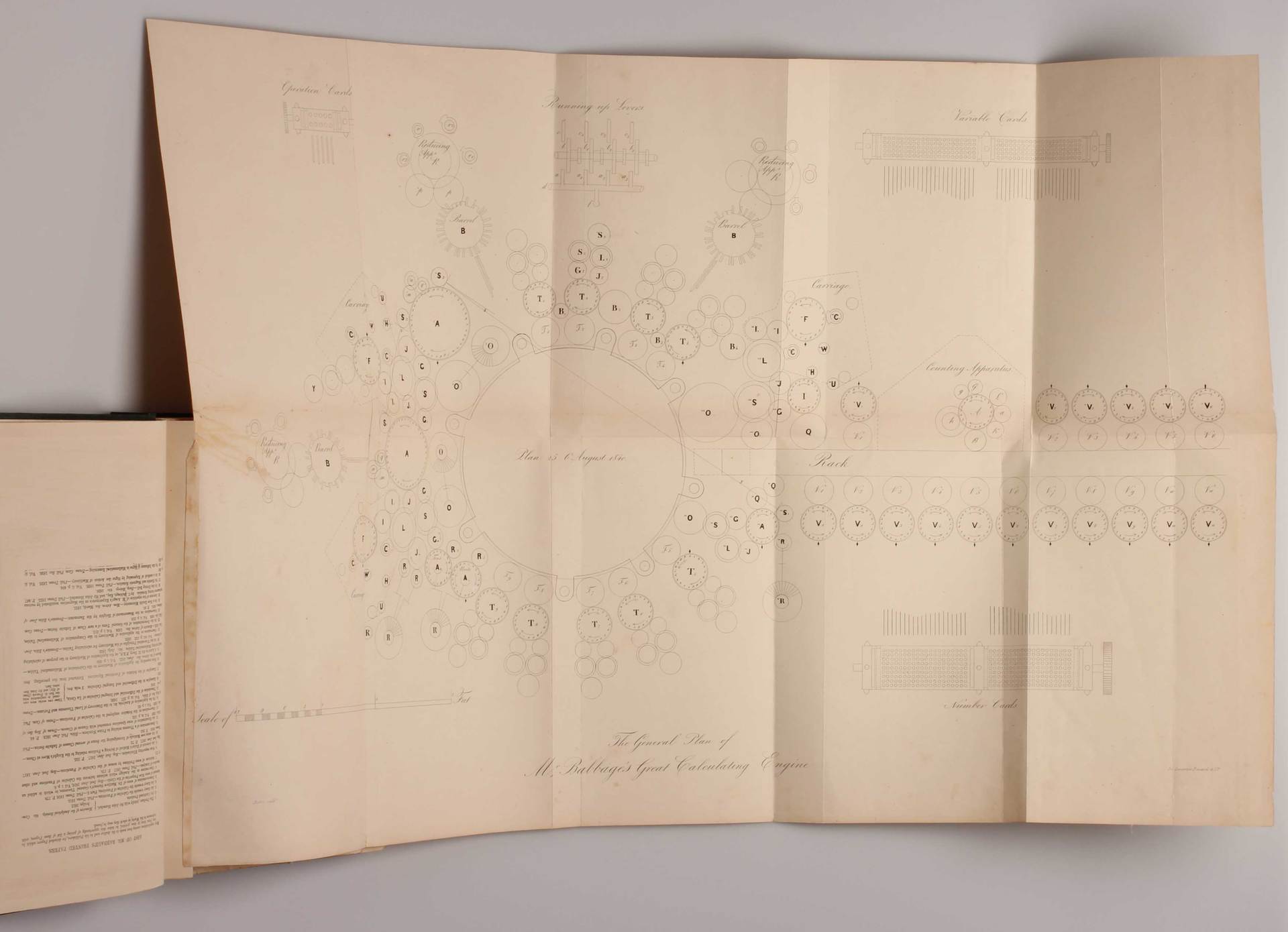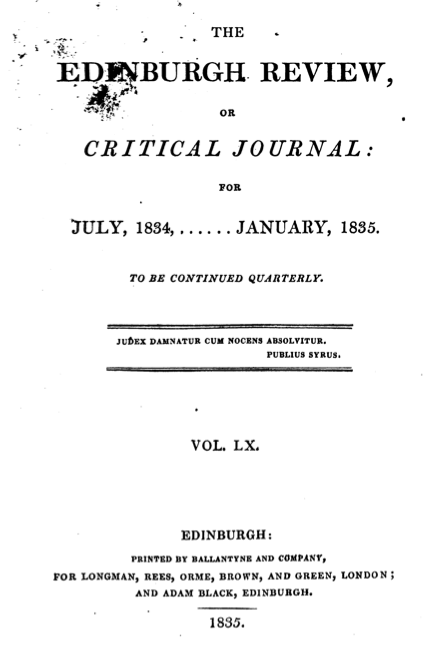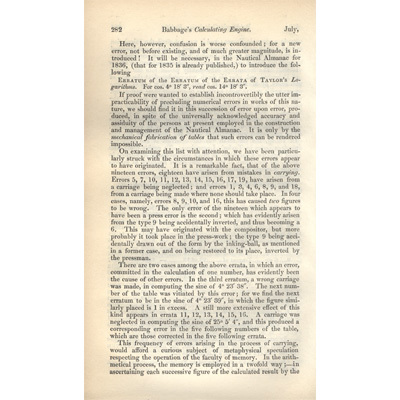When did it all begin?
“A machine is not a thinking creature, it is just an automaton that fulfills its inherent principle ”
Luigi Menabrea, 1842

Yesterday I had a curious dream. There I was interviewed and answered standard questions in the spirit of normal forms of databases. Suddenly, an employee of the company came to my interviewer for some reason. Seeing that a process of interrogation was taking place, he decided to join the process and asked a simple question: “When did it all begin?”. Then, in a dream, I was a little confused, only remembered that Lord Byron had a daughter named Ada, who is considered the first programmer on the first computer. The knowledge was the result of a study of Byron’s biography, and was fixed rather as an additional fact from his life, so I couldn’t remember anything more concrete, because I didn’t know.
Returning to a more material reality, this question did not leave me, and I decided to thoroughly find out the start date, at least a year.
As a beginning, I decided to take the creation of the first working computer and launch it, which is important, since there were many projects of difference machines, but the concrete result, namely, the recorded fact of the calculations made by the machine, is important to us.
The investigation returns to Ada Lovelace.
So, we re-read the article about Ada Lovelace and see that the first machine with which she worked was “ Charles Babbage Difference Machine ”.
Thus, the first computer was called Babbage's Big Difference Machine, but whether it was built, whether it worked, and if so, when. Searches go towards Charles Babbage and his car. The first picture just shows its archival scheme.
Brief biography of Charles Babbage
Charles Babbage (Babbage) - English mathematician, genus. Dec 26 1792 at the Teigumouth in Devonshire, educated at the University of Cambridge, which he graduated in 1814. Of his scientific work, extremely accurate and user-friendly logarithmic tables deserve attention (“A table of the logaritbms of the natural numbers from 1 to 108060 ", 1827). In view of the difficulty of producing such large, accurate tables, B. attacked the thought developed in his essay: “Letter to sir. H. Davy on the application of machinery to mathematical tables ”(1822), compose a special machine for this. Having received funds from the government for the construction of such a machine, B., to study technical details, examined many mechanical workshops in England and abroad, the result of which was his composition: Economy of manufactures and machinery (1832), trans. in German. Friedberg, under the title. "Ueber Maschinen and Fabrikwesen" (Berl., 1833). The machine conceived by B., aimed at calculating and printing mathematical and nautical tables, should have consisted of two essentially different parts: calculating and printing. In 1828, construction began on the first part of the machine, which was almost completed by 1833, when work was interrupted. The second part of the machine, adapted for printing tables, had not yet been brought to half, and its construction costs had already reached 17,000 p. Art., and since the perfect completion of the enterprise required the same amount, the work was completely abandoned. At this time B. together with Herschel and Peacock translated Lacroix, Traité du calcul différentiel et du calcul intégral, and wrote Comparativ view of the different institutions for the assurance of life (1826) and many other scientifically important articles for Philosophical Transactions ”,“ Journal of Science ”by Breister in other periodicals. In 1828, B. received the Department of Mathematics at Cambridge University, but in 1839 left it. In his Reflections on the decline of science in England (1830), he spoke very pessimistically about the state of science in England, which he returned to again in his essay on the exhibition 1851: “The Exposition of 1851, or views of the industry, science and government of England ”(1851). Autobiographical data about him are placed in “Passages from the life of a philosopher” (1864). B.
Go to the article about the car. We see
“In 1823, the first subsidy was paid for the construction of what is now considered the first computer on earth and is known as the Babbage Big Difference Machine. The construction lasted ten years, the design of the machine became more complicated, and in 1833 funding was discontinued. ”
Other sources also found an alternative date for the completion of funding - 1834. And no information about the first calculation. It’s strange. It turned out to be not as simple as we would like.
What is this car like?
“Charles Babbage difference machine is a mechanical apparatus invented by the English mathematician Charles Babbage, designed to automate calculations by approximating functions by polynomials and computing finite differences. The possibility of an approximate representation in the polynomials of logarithms and trigonometric functions allows us to consider this machine as a fairly universal computing device. ”
Yes, judging by the pictures on Wikipedia and articles - that’s still steampunk.
“While developing the machine, Babbage did not represent all the difficulties associated with its implementation, and not only did not meet the promised three years, but also nine years later was forced to suspend his work. However, part of the machine still began to function and performed calculations with even greater accuracy than expected. ”
So the car worked, albeit partially. It follows from this that it can indeed be considered the first computer.
In 1823, the British government granted Charles Babbage a subsidy for the construction of a car. The first estimated date for the appearance of the machine in 1832, since its development took nine years.
The date is confirmed from the article on the assembly of the model of this machine
"This model operates on principles very similar to Babbage's original designs, though the constraints of using only standard Meccano parts inevitably mean some aspects of the operation are somewhat different. "The model can handle decimal numbers with up to four digits, and up to three orders of differences - similar in scope to the fragment of the original Difference Engine # 1 which Babbage actually realized in 1832."
Although some sources featured in 1833.
“... however, by the beginning of 1833, it was possible to finish and test the part of the machine, which can tabulate up to the fifth digit polynomials with constant second differences.”
Wow!
“In 1834, an article by Dr. Dionisy Lardner“ The Babbage Computer ”was published, which describes in detail the principle and structure of the machine.”
This is where the exact dates should be. It remains to find an article.
“... they were inspired by this article by Dr. Dionysius Lardner in Edinburgh Review in 1834,“ The Babbage Computing Machine. ”
So you need to find a scan of this issue, or at least its transcription.
"The Edinburgh Review" is one of the most influential British magazines of the 19th century. The original edition came out from 1802 to 1929, then from 1984 the name began to use the magazine "New Edinburgh Review" (English New Edinburgh Review), published since 1969. The magazine is currently part of the Eurozine magazine network. ”
First scan found in archives: The Edinburgh Review, or Critical Journal: for July, 1834, ....... January, 1835, vol. LX (in the usual numbers it is 60). The release date of 1835 is most likely not what we need, but we know the approximate issue number - 59 or 58, unlikely 57 - respectively LIX, LVIII or LVII.

Archival scan of the magazine in which there is supposedly a full version of the article
We are looking for the coveted article ...
In the process, it turns out that this issue consists of two other sub-issues with a different numbering. The first is CXXI (121), with the release date - October, 1834. The second is CXXII (122), with the release date January, 1835.
In order to find Lardner's article, you need to find out the Latin spelling of his name. We find. In English, the name Dionysius Lardner is spelled as Dionysius Lardner. It's funny that there is no article about him on the Russian-language wiki, only on the English one. In the future, the original name will come in handy for searching for his article in the archives.
Along the way, we find the first scan of the article in very poor quality and only one page.

Scan of one of the pages of the article by Dionisy Lardner about the Babbage computer. One
can hardly see that the article has only two dates: 1836 and 1835. According to the received data, they do not suit us, but it can be. More importantly, we can see the page number, article title, and month in the upper right corner! Obviously this is the month of issue release - July - which means October does not suit us.
So:
- Page Number - 282
- The exact title of the article is Babbage's Calculating Engine.
- Month - July
Indeed, if you look at the full spread of the previously found issue, you can see that the year of issue is written on the left, and the month on the right.

U-turn of The Edinburgh Review magazine It
remains to find the July 1834 edition of The Edinburgh Review. The numbers LIX and CXX will also help us.
While it is not possible to find the desired release, we turn to other sources.
In one more authoritative (at least in appearance) work, a fact pops up, once again confirming the date of the first assembly and launch of the machine as 1832.

And one more confirmation, along the way we learn about the existence of a toolmaker named Joseph Clement, whom Babbage hired to actually make his first car (the very first one). Thus, another important person appears in the whole story, who actually assembled the first computer on Babbage's projects.

"Joseph Clement (1779-1844) was amongst the finest toolmakers of his generation, both gifted and inventive, winning acclaim and awards for innovations in machine tools. Clement was a toolmaker as well as a first-rate draftsman - a rare combination - and was hired by some of the great pioneering engineers of the day, including Joseph Bramah and Henry Maudsley. Babbage hired Clement sometime in the mid-1820s to make Difference Engine No.1. Babbage designed and sketched the mechanisms and Clement made them, often devising specialized tools. The collaboration was close and it is impossible to say how much of the detailed implementation is Clement's and how much Babbage's. Clement made the 'beautiful fragment' - the demonstration piece for Difference Engine No. 1 delivered to Babbage in 1832- one of the finest examples of precision manufacture of the time. In a real sense Clement was the first computer engineer. "
In the end, I managed to find the cherished issue of The Edinburgh Review. Below is a link to the archive with pdfs, there open “The_Edinburgh_Review_Or_Critical_Journal Vol. LIX .pdf. " The article starts on page 263 and ends on 327. Unfortunately, the article does not contain information on the date of the first launch of the machine, it only says that from 1829 to the beginning of 1833 the development process was slow and intermittent until it completely stopped. Nevertheless, the document is important and interesting and plays a big role not only in Babbage’s life, but also in the history of our entire IT industry.
This concludes the investigation, completely and completely convinced that everything began in the 1832th year. In addition to the date, I can now tell a whole story, but this is already in a different dream. Of course, I would like to know the exact date of the demonstration, clinging to this fact: “A small demonstration assembly was built and delivered to Babbage by Clement in 1832.”, and ideally, to find out not only the exact date, but also in what mood Joseph and Charles were, and what specific calculations were made.
PS Suddenly the name Johann Helfrich Müller surfaced with his first development of difference machines that Babbage might have used. Maybe in fact he is the creator of the first car, and not Babbage any? Perhaps I will delve into this question some other time.
Sources
Archive with pdfs and pictures - yadi.sk/d/dNQu6p3wb8if4
https://en.wikipedia.org/wiki/Lavlice, Ada
ru.wikipedia.org/wiki/Difference_Charles_Babbage_machine www.meccano.us/difference_enginesr computer.com/MechanicalCalculators/18thCentury/Muller.html habrahabr.ru/post/80800 habrahabr.ru/post/80334 https://ru.wikisource.org/wiki/ESBE/Babbage, Charles www.many-books.org/ auth / 506 / book / 56631 / gibson_uilyam / mashina_razlichiy / read / 86 www.computerhistory.org/babbage/dionysiuslardner www.computerhistory.org/babbage/josephclement www.sophiararebooks.com/pages/books/2605/charles-babbage/babbage -calculating-engines-being-a-collection-of-papers-relating-to-them-their-history-and
